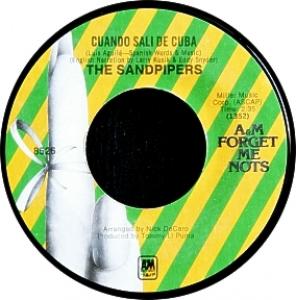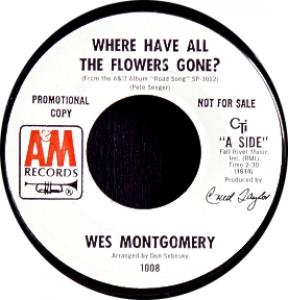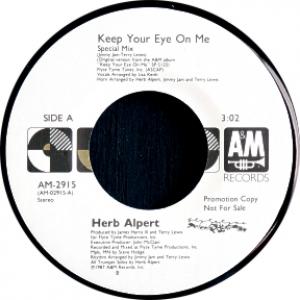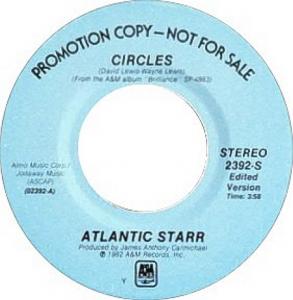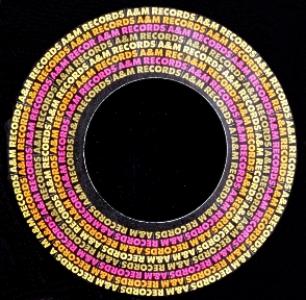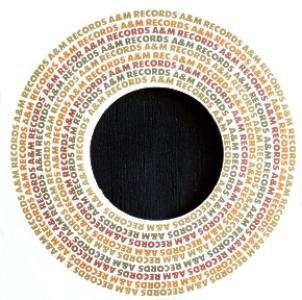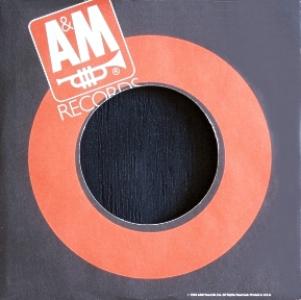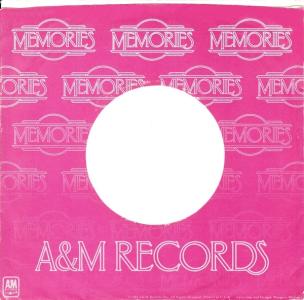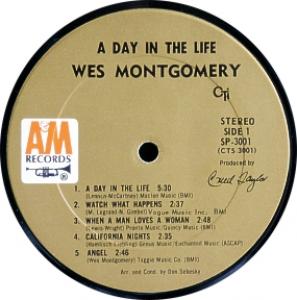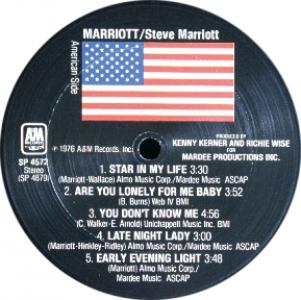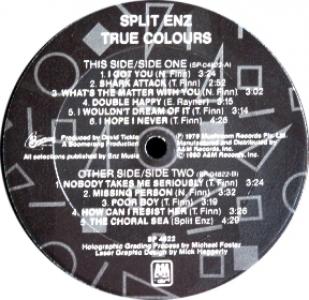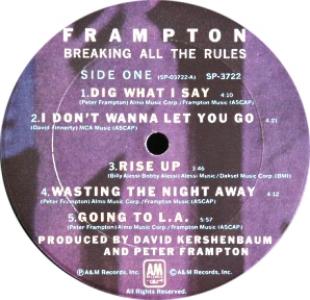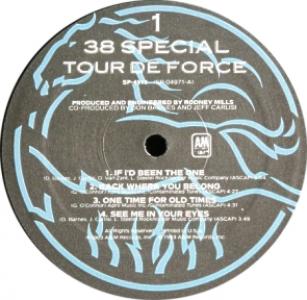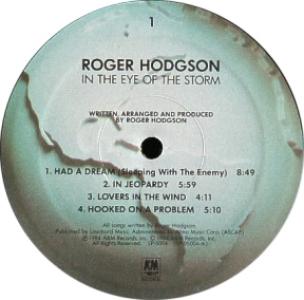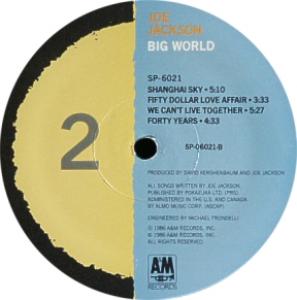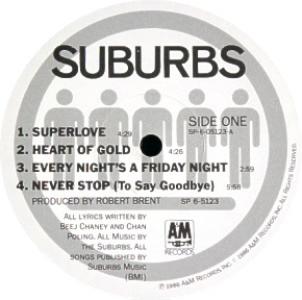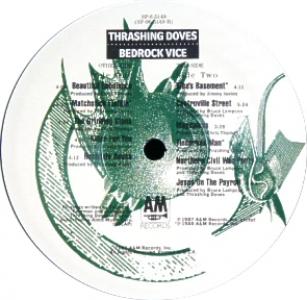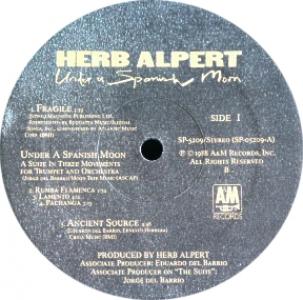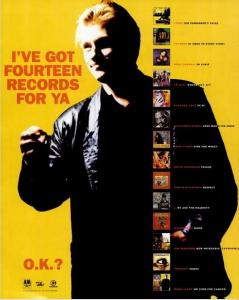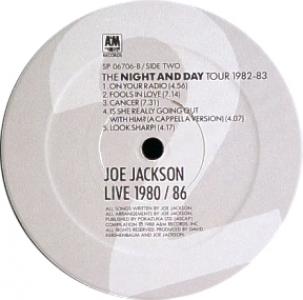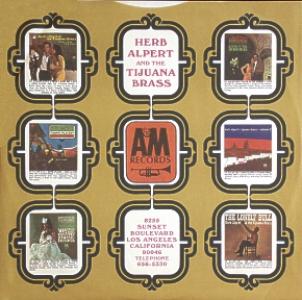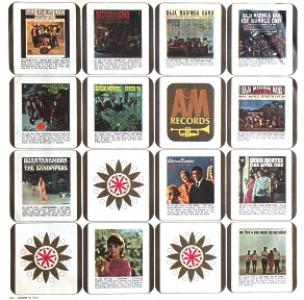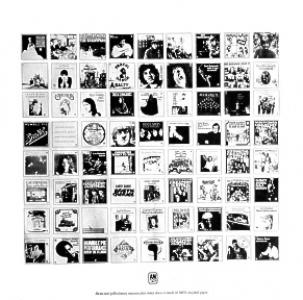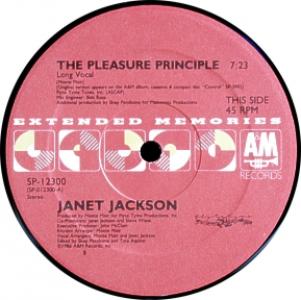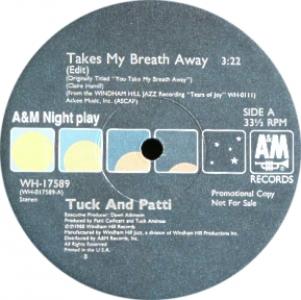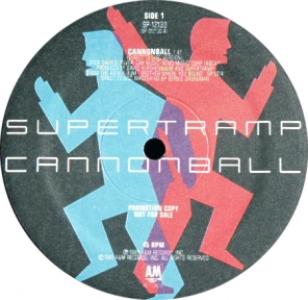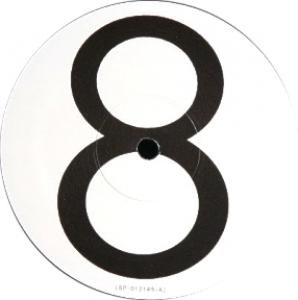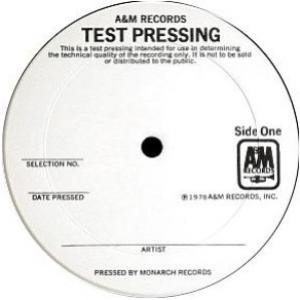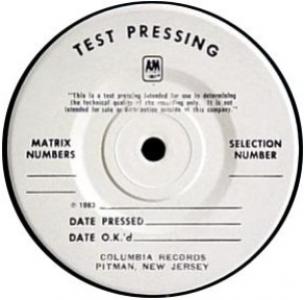A&M RECORDS U.S. LABELS & SLEEVES
- INTRO
- 7" HISTORY
- 7" LABELS
- ALBUM HISTORY
- ALBUM LABELS
- 12" SINGLES
- TEST PRESSINGS
- 4-TRACK TAPE
- 8-TRACK TAPE
- CD LONGBOX
- PRESSING PLANTS
A&M LABELS, LINERS AND SLEEVES HISTORY
In the age of compact discs and digital formats, album and single labels and sleeves seem quaint and company packaging and identification have been reduced to fine print and tiny graphics or eliminated. In the vinyl age, the label started as the primary souce of information and the the record label logo and name were the central design elements on the generic single sleeve. Album liners might promote other recordings or special offers from the company.
The labels placed on vinyl albums and 45s and the record company's generic sleeves and album liners are important for both serious and casual record collectors for a number of reasons. Labels, liners and sleeves can contain information that helps collectors determine the release date, the edition of a record and its value on the market. For collectible records, the edition is a major determinant of its value. When A&M reprinted its albums and singles after a change in its label design, the reprints always carried the latest label and are always less desirable than the original printing. Let's look at the relevance of the labels, liners and sleeves.
A&M RECORDs 7-INCH SINGLES HISTORY
ACTIVE SINGLES SERIES NUMBERING
Jerry Moss started the single stock numbers at 701 because a higher number gave the impression of an established company. This is the original series that ran through 3023. Stock numbers may be shown as 850 or 850-S. The S denotes stereo in its early days.
The AM 1200 and AM 1400 series of the late 1980s were also active singles.
7-INCH SLEEVES
Until the 1980s, picture sleeves were reserved for well-known, better-selling artists. This was because picture sleeves were more expensive to produce. New artists or those signed only to record singles had their work issued in generic record company sleeves. The sleeve functioned to advertise the record company with its use of a large company logo or memorable design.
7-INCH STOCK SINGLE LABELS
Singles 701 and 702 were issued as Carnival Records. From 703 through 3023, singles were on the A&M Records label. These singles were never reprinted.
Singles 703 through 711 had tan labels with brown ink. The earliest of these singles did not have a logo but an italic Times New Roman "A&M Records" on the left side of the label. These singles were reissued with the gold label.
Singles 712 through 1482 were printed on the familiar gold label (sometimes called brown or ochre) and introduced the A&M logo with the A and M in orange, Records and trumpet in black.
Singles 1483 through 2274 were printed on a graduated gray halftone with stylized A and M curving around the edge of the label in a brown tone reminiscent of the gold label used on earlier singles and albums. This series of labels did not have a defined format until number 1516.
Singles 2275 through 3023, the AM 1200 and AM 1400 series labels had red labels with black type and white logo.
For the conversion to the silver label and then to the red label, the stock numbers of when the change occurred are variable depending on which pressing pant the record came from. It waas often the practice to exhaust the supply of the older label before using the new one.
7-INCH PROMOTIONAL SINGLE LABELS
Singles 703 through 717 (?) were released on a white label with block typography. The A&M Records logo was on the left side of the label and did not yet have a border.
Singles 718 through 1319 (?) used a white label, black typography, and the A, ampersand and M were in orange. The logo border was added around 861 and continued in use through 1490.
Singles 1320 (?) through 1490 were white label. The A side of the single had the stereo version of the song. Information about the recording was printed in red ink and "promotional copy," "not for sale" and "A side" were printed in black. The B side was monaural with information printed in black and the logo in color. From 1320 through 1377, the type face was Futura. From 1378 through 1490, the font was Times New Roman.
Singles 1491 through 2287 used red ink on the A or stereo side and black ink on the B or monaurual side. "Promotional Copy--Not For Sale" was moved to the top of the label. The logo was now printed in black and located at the bottom center of the label.
Singles 2288 through 3023 used an identical label to the stock--black ink on red background. "Promotional Copy--Not For Sale" either arced around the top of the label or was the last text on the left side of the label.
STYRENE VS. VINYL SINGLES
Monarch Records and Columbia Records plants in Pitman, NJ and Terre Haute, IN pressed A&M singles on styrene. The Columbia plant in Santa Maria, CA pressed only vinyl. The Santa Maria pressings include an S in the vinyl.
How to tell styrene from vinyl. A single made from styrene has a flat edge while a vinyl single's edge will be beveled. Styrene is more brittle than vinyl and if held up to a strong light the styrene may have a reddish appearance.
A&M RECORDS 7-INCH LABELS AND SLEEVES
The 7-inch also known as a 45 or a single was the mainstay for introducing new music to radio and to the record buying public. The discs had paper labels that denoted whether they were stock (commercial) or promotional. They came in either a company (generic) sleeve or a custom sleeve.
Each gallery is arranged chronologically. Click on any image to see its full size.
A&M 7-INCH PROMOTIONAL SINGLES
A&M 7-INCH CUSTOM LABELS
7-INCH SLEEVES
LASER ETCHED VINYL
A&M Records first experimented with laser etching vinyl in 1980. At the time, pirating recordings were a problem for record labels. The idea was that laser etching might be a way to prevent unauthorized copying. The method proved too expensive to use on all recordings. However A&M continued to use it to create some special issues of some of its albums and singles through the 1990s.
A&M ALBUM LABEL HISTORY
STOCK ALBUM LABELS
NOTE: The design of the label on the vinyl helps identify an original album from a reprint. Collectors with a sharp eye will notice differences in printing techniques, color variations, and even the company that pressed the recording because of the location of the raised vinyl ring under the label.
The first three monaural albums (LP 101 through LP 103 or without the LP prefix) were printed on beige lables with Arial narrow typography in brown ink.
With the fourth album, the label color was changed to is golden color. The first ten albums with the gold label, SP 4101 through SP 4110, had the label logo at the top of the label. Reprints of these albums placed the logo on the left side of the label. From SP 4111 through SP 4388 the logo was placed on the left side of the label.
From SP 4389 through SP 5115, the label was a gradient gray halftone. Often called A&M's silver label. It featured the letters A and M curving around the the edge of the label. The logo was moved to the bottom center of the label. The album title, artist and track titles were printed in Futura bold. Track times, songwriters and publisher inforation was set in 6 pt. Futura. It should be noted that SP 4389 was pressed with both the gold and silver labels.
From SP 5117 through SP 5288, A&M albums were printed with a black label. The label was divided by five stylized discs in borders extending through the middle of the label. The A&M logo was in a sixth border at the right side of the label. Futura was used for all typography.
PROMOTIONAL ALBUM LABELS
The first promotional album was S.R.O. by Herb Alpert and the Tijuana Brass. This was the label's 19th album. The first 18 had test pressings.
A&M used three versions of the white label that denoted a promotional only album. From SP 4119 through SP 4415 (?) the logo was in color and always appeared on the left side of the label. From SP 4416 (?) through SP 4765 the promotional label was identical to the stock label except for "Promotional Copy Not For Sale." From SP 4766 through SP 5288, promotional labels were the stock label. Album covers were stamped "Promotional Copy Not for Sale."
CUSTOM ALBUM LABELS
Custom album labels usually depended on whether the artist had negotiated for some graphics rights in his/her contract.
ALBUM LINERS
The record company's inner sleeves for albums often help to date the album in two ways. First, the sleeves may have been printed with information about other recent releases. Second, some companies like A&M Records placed codes on their inner sleeves which helps determine the period for an album release.
A&M RECORDS ALBUM LABELS
The paper labels on vinyl albums denoted whether the album was stock (commercial) or promotional (for radio or retail use only). Custom labels were reserved for special items or those where artists had negotiated to have the right to have custom labels made for their projects.
Galleries are arranged chronologically. Click on the image to see its full size.
A&M RECORDS STOCK ALBUM LABELS
A&M 12-INCH SINGLES
In the late 1970s, 12-inch singles were used for FM radio, night clubs, and for sale to the record buying public. Like the 7-inch, 12-inch singles were labeled as stock (commercial) or promotional only and were served in company (generic) or custom sleeves.
Galleries are arranged chronologically. Click on any image to see its full size.
A&M RECORDS TEST PRESSINGS
Test pressings were used as quality control before the mass printing of an album or single.
Galleries are arranged chronologically. Click on any image to see its full size.
COMPACT DISC LONGBOX
The CD longbox was created for two uses in retail stores. The longboxes allowed CDs to be displayed in either 7-inch or album racks and the added size acted as a deterrent to shoplifting.
The longboxes shown below are in chronological order of use beginning in the mid1980s.
PRESSING PLANTS
A&M Records used a number of record manufacturers including Monarch Records, Columbia Records, RCA Reords and ElectroSound. Columbia and RCA each had several pressing plants. The plant that manufactured the recording is identified by its code which was either stamped near the laquer number in the vinyl or printed on the record's label.
COLUMBIA RECORDS
At the time Columbia was manufacturing A&M's recordings, there were four plants.
Pitman, NJ (initials in the vinyl P, CP and initial on the label X),
Carrollton, GA (initials in the vinyl C and initial on the label W),
Terre Haute, IN (initials in the vinyl CT, CTH, T, TH and initial on the label Y),
Santa Maria, CA (initials in the vinyl CS, CSM or S).
ELECTROSOUND
ElectroSound, located in Shelbyville, IL, produced A&M records in the 1980s. Its code is the letter B that appeared on the label, near the A&M logo on albums.
GOLDISC RECORDING PRODUCTS, INC.
In the early 1980s, these recordings had GD in stamped in the vinyl and the initial A on the label.
MONARCH RECORDS
Monarch was the first to manufacture A&M Records singles.Its symbol was a triangle or delta sign in the vinyl. It also placed MR in a circle for singles and MO for albums and used an X to indicate the B side of the recording.
RCA RECORDS
The lacquer number would include "RCA" or "IND." IND stood for the plant in Indianapolis. An R on the label indicated RCA's pressing plant in Rockaway, NJ, and I for Indianapolis and an H for Hollywood.












